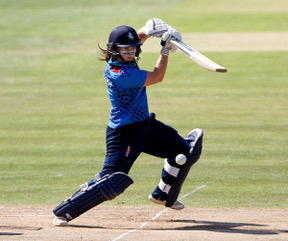(The views expressed in this blog are not necessarily endorsed by KCCC or KCHT)
When Matt Milnes was called up to join Welsh Fire in the Hundred competition, it made me realise a) that I had not known that Mr Milnes had any Welsh connections, and b) that English cricket is killing itself softly with its siren song, Money Money Money.

For Kent, this means that we have lost Crawley to the Hundred and then to the Test squad (about which we should all be proud), and we have lost Billings, Cox, Leaning, Bell-Drummond, Denly, Blake, Klaassen, Milnes, and our overseas players Qais Ahmad and Adam Milne to the Hundred. Have I left anybody out? That’s a complete team, leaving us only with Ollie Robinson, Heino Kuhn and Stevo of our regular first team, alongside Grant Stewart, Marcus O’Riordan, Podders, Matt Quinn and Hami Qadri to make up some of our eleven for the Royal London Cup. After that, we raid the leagues and the Scottish national side to make up the numbers. No wonder our results have not been too good, although I suppose we save a bit on wages.
What’s worse is that we are not the only county suffering this way: most other counties have lost their stars and their not-so-stars to go and play in the Hundred. The big overseas box-office names we were promised have largely not turned up for one reason or another, so now we have two limited overs tournaments taking place at exactly the same time, dipping into the same pool of players, with the inevitable result that one of the competitions must suffer. If I were the sponsorship director of Royal London, I would be very fed up, and taking the decision not to renew the deal with ECB for next year.
On the other hand, if the Hundred is meant to attract a new audience of people who “don’t know they like cricket yet” (in the immortal words of an early bit of ECB promotion), why do they need the big overseas names at all? They won’t mean a thing to those who are new to cricket, while those who do actually care about the game might like to see those big names pitting themselves in the RL Cup against the best 50-over players in the land of the World Cup holders. Surely if anywhere is the place to make your name as a newcomer to professional cricket, it is the Hundred, where the spectators will treat the newest of players in exactly the same way as the seasoned performers, simply because the spectators are also the newest of the new. Let those who know a bit about the game they are watching appreciate the finer skills of the world’s best. Seems only fair.
Let me quote from The Economist of 17th July this year. “All these problems – even the Covid-related ones – seem manageable compared with the existential threat that is young people’s lack of interest in the sport.” The only thing is, the sport in question here is not cricket, it’s baseball. The solutions that baseball seems to be trying, in order to overcome the fact that young Americans are more interested in e-sports than baseball, seem to be identical to those the ECB are taking here – shorten the games and as The Economist says, “pump up the action.” There is apparently an organisation called the Society for American Baseball Research which has discovered that baseball has an extremely conservative culture. This is hardly rocket science. I would suggest that practically every sport has ‘an extremely conservative culture’, and even BMX biking and skateboarding will probably have a conservative culture when they are old enough to have a history. That slows down the pace of change, of course, but it would be wrong to argue, as the man at the Society for American Baseball research does, that “the idea that baseball was somehow better in the past is one we should throw by the wayside. The golden era of baseball is now.” I am not able to judge baseball today, but if they are trying to tweak the game and its rules to make it more exciting, that hardly indicates that they are in a golden era.
I can be sure, however, that the golden era of cricket is not now. Yes, we have great players like James Anderson, Virat Kohli and Ben Stokes, but clearly things are not as they should be. However, the case of Ben Stokes taking indefinite leave of the game to improve his mental health is just one sign that playing more cricket is not the right way to change things. Yet at the same time that more cricket than ever is being played, at Canterbury and at many other county grounds, there is no men’s professional cricket being played throughout almost the entire month of August. Insanity.
The Hundred has no merit whatsoever except that it allows the ECB to control a format of its own, but in doing so they have drastically weakened the county cricket structure. The inevitable consequence of this is that red ball cricket, the staple of the county game, will be permanently weakened, and without red ball cricket there will be no Test cricket, and then the game will have gone. Pretty soon the time will come when even 100 balls is too long, so they have to introduce 50 ball matches, or 10 ball matches, or just the bowl-out, and even then, kids who don’t want to be interested in cricket will just get deeper into their X-boxes or the 2040 equivalent thereof, and cricket will become another knur and spell, a game that in olden times was played in England.

This is why the Hundred is wrong. It is a format too far. It may bring in money to the ECB, but there is no evidence yet that they are going to distribute it wisely. The cricket is no better and the crowds no bigger than at T20 matches, whatever the television commentators may say. It may bring in a few new fans for that form of the game, but how many of them will become red ball cricket fans is very much open to doubt. It may make a few cricketers richer, which is not a bad thing and nobody blames any professional who takes the Hundred’s wages, but will it bring more cricketers into the professional pipeline? It is certainly raising the awareness of of women’s cricket, which is an unqualified good thing, but we didn’t need a new competition to do that. And by breaking the county structure it will do nothing to help girls (and boys) at 14, 15 and 16 years old to get access to top quality coaching and competitive games.
The trouble is, the Hundred is almost certainly here to stay. Forget the past and crack on into cricket’s brave new world. Today is today and yesterday is history.
0 Comments